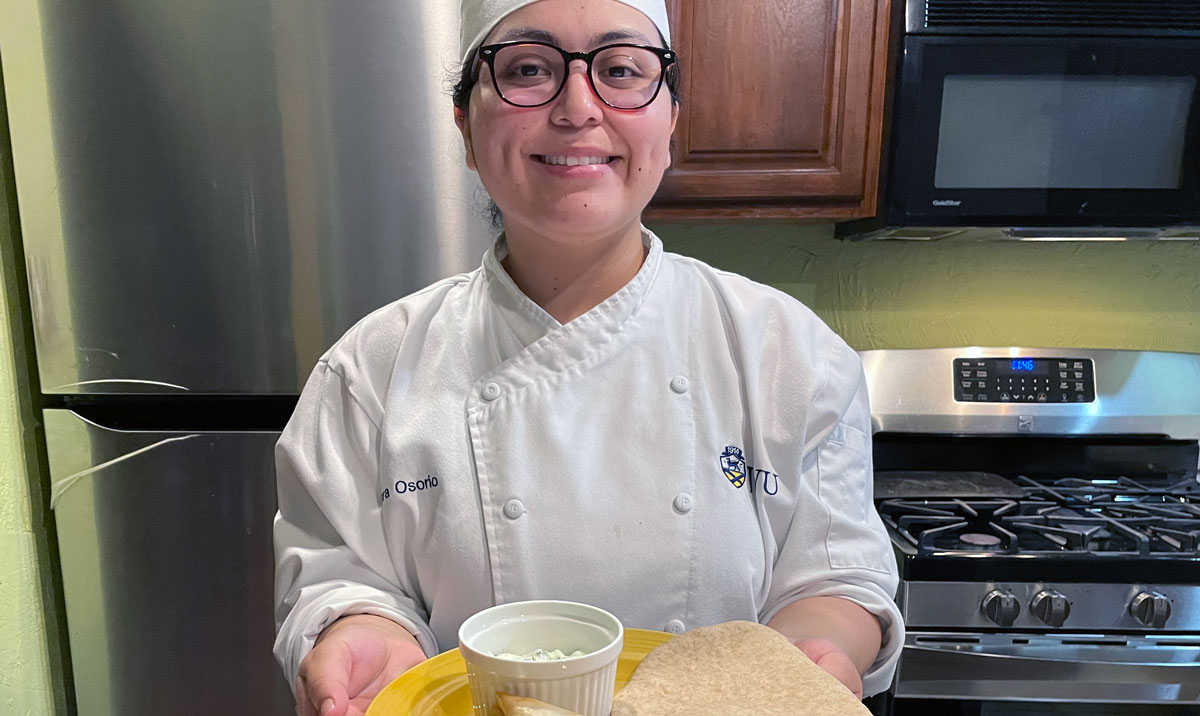A cast member in Disneyland’s Quick Serve restaurants, Sara Osorio had all but given up on her dream of a culinary education. However, through Disney Aspire, an educational investment program that provides Disney’s cast members and other employees with resources they need to achieve their educational goals, Sara saw an opportunity to achieve her dream. Through a partnership with Disney Aspire and Guild Education, Sara received 100% tuition coverage and a stipend to complete the JWU Online Professional Culinary Skills Certificate.
For Sara, the opportunity she received from the Disney Aspire – Guild Education partnership to attend JWU’s culinary program turned her dream of a culinary education into a dream come true.
SARA’S DREAM
I had been working at Disney for almost four years when I saw an announcement pop up on “the hub” (a web-based information site for cast members) about a new culinary program. The announcement read something like: ’You, too, can be a chef.’ Curious to learn more, I saw that Disney was introducing Johnson & Wales Online into its Aspire program, and any US-based hourly full- or part-time cast member could apply to earn a Professional Culinary Skills certificate. I thought to myself, ‘You know what? I’m going to go for it!’
I had dreamed about going to culinary school while I was growing up. But in high school, I got a lot of pressure to go to a traditional college and get a degree. My mom was concerned that culinary school might not be the best investment for my future; she urged me to “just go to college.” So, I took the traditional route of getting a bachelor’s degree in Business Management and Human Resources.
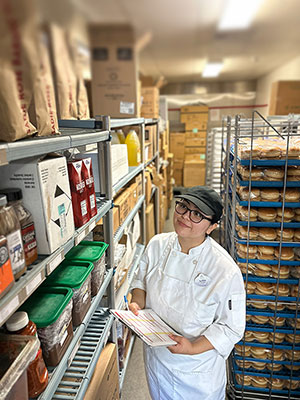
As I graduated college, the expectation was that I start working in a business or human resources career. I had worked hard to earn my degree, but I couldn’t find a job related to what I had studied. I felt so discouraged. I didn’t know what kind of work I even wanted to do.
My first job while still in high school had been at a Smart & Final, one of the warehouse-style food and supply stores nearby. I started as a service clerk. At 16, I wasn’t able to work as a cashier until I turned 18. After working for three years at Smart & Final I finally became a cashier. I had taken a lot of training to advance into that position, but then I just wasn’t feeling interested anymore.
Many people living in my area go to work at Disney after high school. And I knew people from my high school who were working for Disney. I thought, ‘Let me give it a shot.’
Disney inspires longevity. November 2023 will be my fifth year with the company. However, compared to my coworkers — some of whom have been Disney employees 10, 15 or even 30 years — I’m just a ‘baby’ in the company. Most of the time I work in the Quick Service restaurants in “Hollywood Land” and “Carsland”, where you can order food, and then find somewhere to sit and eat. Because it’s not table service, it’s a faster turnaround. I’ve been cross-training in other food and beverage-related positions within my department. I can fill in to prep or serve as an order cook.
Training at Disney to prep and cook reawakened my interest in the culinary arts and in preparing food in my home kitchen. When I saw the announcement about JWU’s online Professional Culinary Skills program on the Disney Aspire Hub, I was excited — the announcement revived my dream of having a culinary career. Especially because the partnership between Disney and Guild Education pays 100% of the tuition, the program was the perfect opportunity for me.
CULINARY SCHOOL
When I told people I was in JWU’s culinary program, they would ask me, “Oh, are you going to be a chef?” I’m not really sure yet what I will do after completing the program. I just know that my classes at JWU have inspired me to keep learning about the culinary arts.
JWU sent me pots and pans, a spice rack, a cutlery set, and the camera to record myself preparing food. They sent me a chef’s coat with my name embroidered on it, and with the school logo. I also received sanitizer buckets because I was required to take a food safety management course. An added benefit is that I earned a Conference for Food Protection Approved Food Safety Manager Certification, which is good for five years.
I loved taking pictures of my finished products for class assignments – and then posting the photos on social media. I was excited when friends and family commented, “Oh, wow!” In my mind, I wasn’t doing anything special – just following instructions. When I said that to a friend, she told me that she had made that same comment to her professor, and he replied, “You’d be surprised how many people cannot follow instructions!”
A CHALLENGING PROGRAM

Some weeks I found it difficult to keep up with the amount of work the program required, while continuing to work full time at Disney. On my days off, I worked on school assignments. In the beginning, while struggling to stay afloat, I would sometimes get behind and submit assignments after the due date. I made every effort to catch up quickly, knowing that if I got too far behind it would be difficult to catch up.
Then I realized I could take advantage of the head start week that the chef instructors give. Working on assignments as soon as the class opens up – a week before the semester officially begins – helped me keep up with the workload during the program.
Each week during the program, I watched a video of the basic techniques. Then, I filmed myself as I followed the recipes to make the dishes. On each video, I introduced myself, and displayed my ID to prove my identity. After recording everything, I edited it down, and submitted it with an outline of what I had done in the video. After the chef instructors reviewed my videos, they would make a video for me with their feedback and tips about how I could improve my cooking techniques.
Filming and editing the videos of myself preparing food for each class took a lot of time. I had no prior experience in editing videos. Fortunately, my first course started off with an easy assignment — setting a table. Editing the first video familiarized me with Kaltura, the video software program. I was relieved to find it is easy to use; I would just delete frames I didn’t want in the final cut of the video.
The program wasn’t easy – especially balancing school with work – but it was worth it in the end. I could have taken the summer semester off, but I wouldn’t have finished until late fall 2023. I felt like I was in the groove of things, and I wanted to keep going. Without taking a break, I was able to graduate in August 2023, just one year after I began.
SENSORY EVALUATION
One of the most challenging – and interesting – aspects of the program was learning how to communicate the sensory qualities of the dishes I made. Obviously, the chef instructors could not taste or smell the food I was making. I wondered how I could express what a green bean tastes like? Or the texture of asparagus? How does the silky gravlax (salmon) feel in my mouth, compared with the crisp-crunchiness of the celery root and apple salad that I paired with the gravlax? And what words can I use to describe an elusive aroma?
Struggling at the beginning of the program, I would search online to read about how others described sensory qualities of different ingredients. At first, I couldn’t distinguish well between basil and thyme. Now when I eat a dish flavored with basil or thyme, I know which herb it is.
Certain potatoes are described as having an “earthy” taste. I’d think to myself, ‘So, this is what “earthy” tastes like —the scent of freshly turned earth in a garden, but not unpleasant. The next time I encountered that scent or taste again, I could identify and describe it as being earthy. Throughout the program, I built up my sensory terminology. At the end of every video that I filmed of myself preparing food, I completed a sensory evaluation. I printed out a chart on which I described the visual appearance of the dish, the aroma, texture, feel in my mouth (“mouthfeel”), and finally, the taste.
SHARING A PASSION FOR FOOD
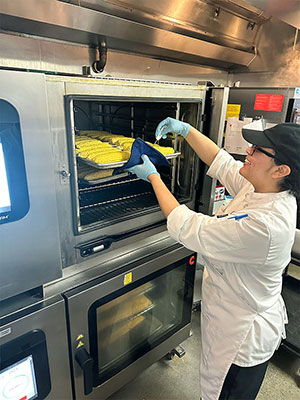
Before I enrolled in the culinary program, I rarely cooked at home. It has been fun to experiment with cooking and also tasting new culinary dishes – many of which I would never have known about before going to school. The certificate program taught me essential skills to prepare food for myself, my family, and my friends – skills I think everyone needs in life.
Some friends have liked my cooking so much, that when I let them know I had leftovers, they would drive to my house to pick up the food! My mom became the main “taster” for all my dishes. I taught my mom a little about the sensory qualities of food. She learned some vocabulary, so she could evaluate the dishes I made for class assignments. An added benefit of the program is how much fun we had working together.
HIGHLIGHTS OF THE PROGRAM
Looking back, in addition to learning the basic skills of food preparation, I appreciate having learned about safety and sanitation, and sustainability. These skills are important for working in food prep and cooking at Disney. My favorite parts of the program were learning about the scientific method of cooking and baking, learning to work with costing cards, and plating the dishes.
We learned about the yield test, which is a procedure for computing the actual costs of food products that will lose weight and/or volume during preparation. For example, if you have two pounds of a product, like a cut of meat, you can calculate the percentage of waste after you have cleaned, trimmed and cooked it. The yield test lets you know how much product you really need to purchase if you want to end up with two pounds for the recipe. Knowing that information is crucial to the recipe’s success.
Working with costing cards was especially useful. I liked that we used Microsoft Excel. A lot of people have little to no experience using Excel, which is so helpful for calculating costs of the ingredients used in recipes. In Excel, I could see the price of purchase for each individual ingredient. Factoring in the proportions of each ingredient in the recipe, and including costs for overhead and labor, the cost of the recipe can be calculated. Then I could figure out how much one serving would cost, so that the dish could be priced for the menu.
Jennifer Gallagher, the chef instructor who taught the principles of the plate, opened my eyes to the importance of presentation. I love how plating a dish requires technique – for example, artful cuts – and also creativity in how the food is arranged according to colors, textures and proportions. During the course, and for every course afterwards, I followed the guidelines I was given, but then found ways in which I could be imaginative and have fun with the plating.
INTERNATIONAL CUISINE AND CAPSTONE PROJECT
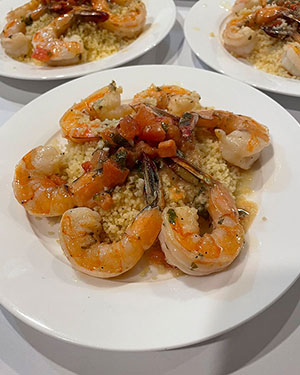
For each of the classes except the final one, I would re-submit all the assignments from that course as a final project. However, the final course is the heavy-weight class, in which we complete a capstone project in international cuisine. I’m accustomed to being in my little own culinary bubble where I live in California — we have a lot of Mexican food and fast-food restaurants. So, it was interesting to step outside of my accustomed food choices to create dishes from two different countries.
Of the three choices: Peru and China, Vietnam and France, or England and India, I decided to prepare cuisine from Peru and China. Part of the assignment was to create a PowerPoint, displaying a little bit of research into the cultures and the foods you find within those regions. I discovered there is a fusion of cuisine between Peru and China because Chinese immigrants popularized Chinese food in Peru. The Chinese Peruvian fusion cuisine is called “Chifa.”
Fascinated, because I had never heard of Chifa, I looked for any restaurants close to home that serves Chinese Peruvian food. Uncommon in my area, one restaurant was all the way in Los Angeles. I visited the restaurant with some friends to help me research my project. I enjoyed eating the cuisine I would prepare for the capstone project, seeing how the food was presented and experiencing the flavors.
When I prepared Chinese Peruvian cuisine myself, I enjoyed combining all of these ingredients. Individually, each ingredient has a distinct aroma and taste. In combination, they become one very delicious dish that you can share with people. Seeing people enjoy the food I prepared is so rewarding!
SUPPORTIVE INSTRUCTORS AND STAFF
When I read the chef instructor’s bios, I was amazed, thinking: ‘Wow, they have so much experience. They’ve been everywhere. They’ve been directors of this and head chef of that.’ I felt so fortunate to be learning from them. They have all this knowledge, and they’re able to give me feedback to help me improve my cooking techniques.
All of the chef instructors responded quickly when I emailed with questions. Some would get back to me in 10 or 20 minutes, or after a few hours. That was different compared with the experiences I’ve had at other schools in the past, where professors might take a few days to respond.
I am thankful for Sarah David, the JWU Admissions Associate who helped me enroll. I am also grateful for the support from my Guild Education coach, Megan.
All of my chef instructors helped me grow and inspired me to succeed in the program. I learned a lot from my first chef instructor, Thomas DeRosa, and from Scott Smith, who is the Director of the Online Culinary Programs. Scott Richardson taught the breakfast course – breakfast and lunch plates – which I thought was a very cool class. And Jennifer Gallagher, who inspired my enthusiasm for plating.
My wish is to continue learning how to prepare cuisine – especially baking and pastry – and to possibly become a chef. I’ve also come up with some recipe ideas for a few of the locations where I work. Before enrolling in the culinary program, I created a PowerPoint, with images of food representing my ideas. I showed it to a few managers and chefs. One manager loved one of my food items; she said they would try to produce it.
Although that hasn’t happened yet, I hope that someday one of my ideas will be put into production. I believe the food ideas I am presenting to the company have potential to become popular and add revenue through sales – especially because the items are visually appealing and would be “Instagrammable.” Whether or not the company implements my creative ideas, I hope to have the opportunity to apply at Disney what I’ve learned in the culinary program.
NEVER TOO LATE
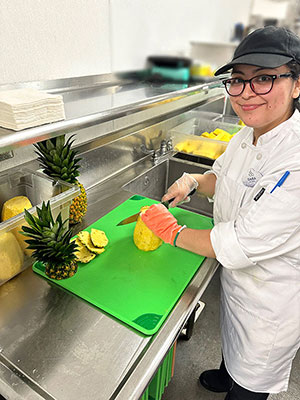
When the last class ended in August, I could hardly wrap my head around the realization that I had completed the program. I felt a sense of relief – and also disbelief – that I had met the challenge of balancing school and work to earn the certificate.
I still wonder what would have happened if I had been able to go to culinary school right after high school. For quite a while, I worried that it might be too late for me to start a culinary career. Now, I think that it’s never too late to pursue your passion. Completing the program has given me new hope that this is just one step towards building a lifelong culinary career.
I am grateful to the partnership of Disney Aspire – Guild Education for the opportunity to earn the Professional Culinary Skills Certificate, and to JWU Online for a real-world culinary education. Earning the degree has helped me believe in myself and have the courage to make my culinary dreams come true.
